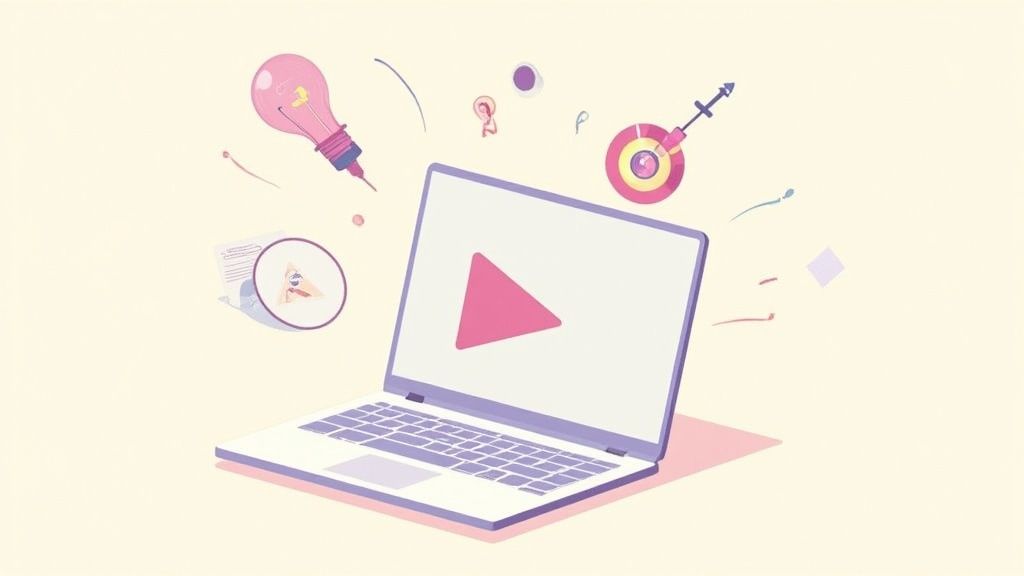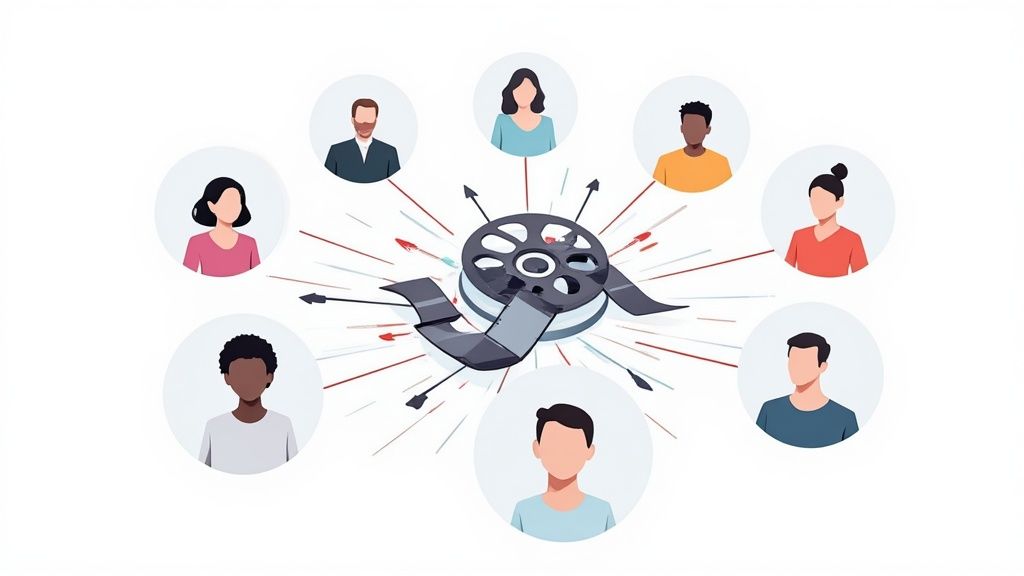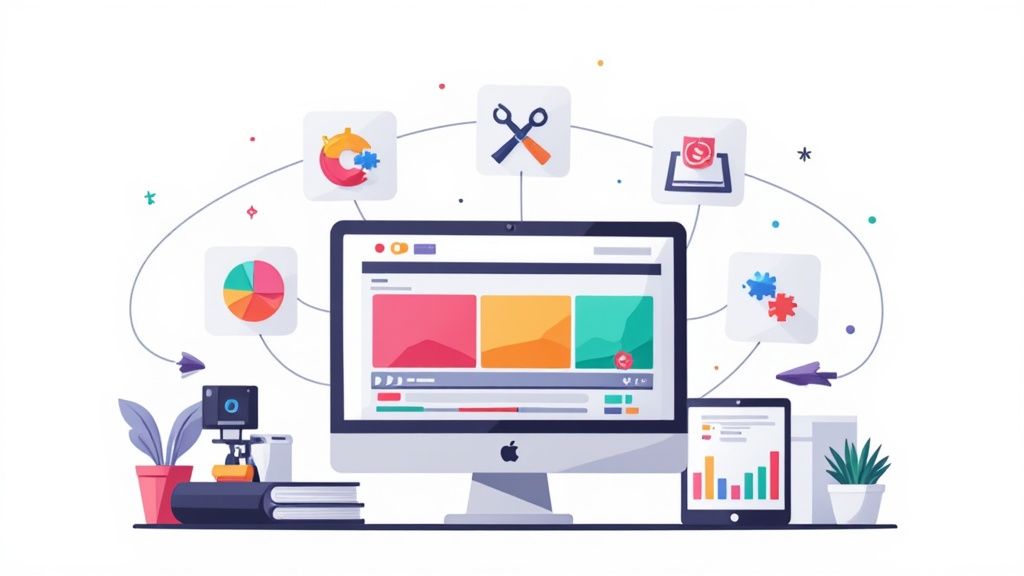8 Tips For Improving Product Demos Experience To Close More Deals



8 Tips For Improving Product Demos Experience To Close More Deals
In the competitive world of SaaS and B2B sales, a product demo is more than just a feature showcase. It's the pivotal moment where a prospect decides if your solution is their future. A generic, one-size-fits-all presentation no longer cuts it. Today's buyers demand a personalized, value-driven experience that speaks directly to their pain points and business goals. Shifting from a simple presentation to a compelling narrative is the key to transforming interest into commitment. To truly evolve from just showing to strategically selling, it's crucial to continuously leverage proven strategies to improve your B2B sales process and treat the demo as a critical closing tool, not just a technical walkthrough.
This guide provides a strategic blueprint with 8 tips for improving product demos experience to close more deals. We will move beyond the basics and dive into actionable techniques that turn your presentation into a decisive conversation. You will learn how to:
- Prepare effectively by deeply understanding your audience before you even share your screen.
- Structure your demo as a compelling story that focuses on business outcomes, not just a list of features.
- Engage your prospects with interactive elements and handle their objections proactively.
- Create a seamless flow and follow up strategically to maintain momentum after the call ends.
By mastering these techniques, you'll not only hold your audience's attention but also clearly demonstrate undeniable value, paving a smoother path from demonstration to a signed contract. Let’s explore how to transform your product demos into a powerful revenue-generating engine.
1. Know Your Audience Before the Demo
Walking into a product demo without understanding your audience is like trying to solve a puzzle with half the pieces missing. You might show off impressive features, but they won't resonate if they don't address the specific challenges and goals of the people in the room. This foundational step involves comprehensive research into your prospect’s business, their role, their industry's unique pressures, and their specific pain points. A truly effective product demo experience is never one-size-fits-all; it's a personalized solution to a known problem.
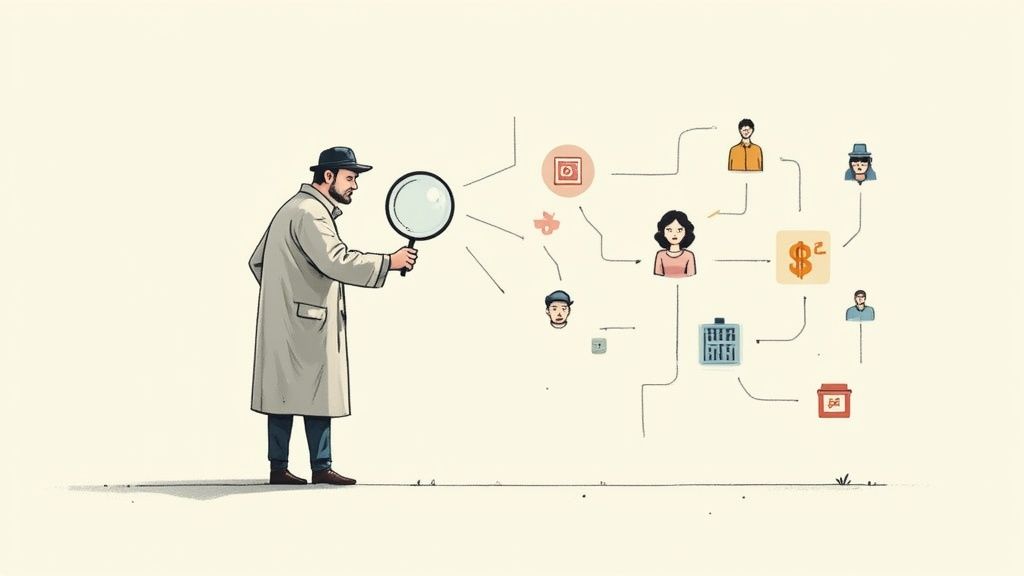
This approach, championed by methodologies like SPIN Selling and the Challenger Sale, shifts the demo from a generic product tour to a strategic conversation. For example, a Salesforce representative researches a prospect's current CRM, identifying gaps in their sales process before the call. Similarly, a HubSpot specialist analyzes a company's marketing automation maturity to tailor their presentation to the right level of complexity. This level of preparation ensures every minute of the demo is relevant and valuable, directly tying your product's capabilities to their business outcomes. The primary benefit is building immediate trust and demonstrating that you are a problem-solver, not just a vendor.
How to Implement This Strategy
To effectively research your audience, you need to go beyond a quick glance at their company website. A multi-pronged approach will give you the deep insights needed to customize your presentation.
- Send a Pre-Demo Questionnaire: 24-48 hours before the meeting, send a brief survey asking about their top priorities, current tools, and key success metrics. This shows you value their time and allows you to prepare a targeted agenda.
- Leverage Professional Networks: Use LinkedIn to understand the professional background of each attendee, their role, and their recent activity. Review their company's page for recent news, press releases, or strategic announcements.
- Analyze Discovery Call Notes: Revisit notes from initial discovery calls. Pinpoint the exact language the prospect used to describe their challenges and use that same terminology in your demo to build rapport.
Key Insight: A customized demo doesn't just show what your product can do; it shows what your product will do for them. This subtle shift in focus is crucial for improving your product demos experience to close more deals.
By investing time in pre-demo research, you position yourself as a strategic partner. This preparation is a critical first step in properly educating your prospects, a concept you can explore further by learning more about educating customers on your product. When you demonstrate a genuine understanding of their world, your product becomes the logical solution to their specific problems, dramatically increasing your chances of closing the deal.
2. Create a Compelling Demo Story
Features and functions are forgettable, but stories stick. A great product demo isn't a list of what your product does; it's a narrative that guides the prospect from a state of challenge to a state of resolution. Structuring your demo as a compelling story transforms a technical walkthrough into an engaging and memorable experience. It frames your product not as a tool, but as the hero that helps your customer overcome their specific business villain, whether that's inefficiency, lost revenue, or operational chaos.

This narrative approach, popularized by strategic consultants like Andy Raskin and methodologies like Demo2Win, focuses on emotional connection and clear business value. For instance, Asana demos often tell a story of a project manager drowning in emails and spreadsheets, then show how their platform brings clarity and order, leading to a successful project launch. Similarly, Shopify walks prospects through the exciting journey of launching an online store, from idea to first sale. This method makes the value proposition tangible and relatable, which is a key part of improving product demos experience to close more deals.
How to Implement This Strategy
Crafting a narrative requires you to think like a storyteller, with a clear beginning, middle, and end. The goal is to make the prospect the protagonist of the story you are telling.
- Establish a Relatable Scenario: Begin with a "day in the life" narrative that mirrors the prospect's reality. Use the pain points you discovered during your research to set the scene, making the problem feel immediate and real.
- Introduce Conflict and Resolution: Clearly articulate the business challenges (the conflict) caused by their current processes. Then, introduce your product's features one by one as the specific solutions that resolve each part of the conflict.
- Show the "Happily Ever After": Conclude the story by showing the positive business outcomes. Use specific metrics and tangible results to paint a picture of their future success with your product, like "reduced manual data entry by 15 hours per week" or "increased lead conversion by 25%."
Key Insight: Prospects don't buy features; they buy better versions of themselves and their businesses. A story is the most effective way to show them what that better version looks like.
By weaving a narrative, you connect with prospects on an emotional level while logically demonstrating your product's ROI. This storytelling technique is fundamental to building a strong connection, similar to how leading companies build their entire identity around a narrative. To see this in action, you can explore some powerful brand story examples. When your demo tells a story they see themselves in, your solution becomes the only logical next chapter.
3. Focus on Business Outcomes, Not Features
Prospects don't buy products; they buy better versions of themselves and their businesses. A common mistake in product demos is getting lost in a feature-by-feature tour, overwhelming the audience with technical jargon and functionality they don't need. The most effective demos shift the narrative from "what our product does" to "what our product does for you." This value-based selling approach connects every feature directly to a tangible business outcome, such as increased revenue, reduced operational costs, or improved customer satisfaction.

This methodology is a core component of frameworks like the Challenger Sale and MEDDIC, which prioritize demonstrating clear ROI. For instance, instead of just showing Tableau's drag-and-drop interface, a great demo illustrates how that feature enables marketing teams to build campaign performance dashboards in minutes, leading to 15% faster decision-making on ad spend. Similarly, Workday doesn't just present its automated payroll module; it showcases how it reduces payroll errors by 98% and saves the HR team 20 hours per month. This pivot transforms your product from a "nice-to-have" tool into an essential solution for achieving their strategic goals.
How to Implement This Strategy
To successfully orient your demo around business outcomes, you must translate every click and feature into a quantifiable benefit. This requires a deep understanding of your prospect's KPIs and a disciplined approach to storytelling.
- Lead with the Problem, Not the Product: Start each segment of your demo by restating a specific business problem you uncovered during discovery. For example, say, "You mentioned your team spends too much time on manual data entry," before introducing your automation feature.
- Use the "So What?" Test: For every feature you show, ask yourself, "So what?" The answer should be a clear business benefit. "This feature integrates with your CRM..." so that "...your sales team has a single source of truth, reducing lead response time by 30%."
- Reference Customer Success Metrics: Use anonymized but specific data from similar customers. Saying, "Clients in your industry typically see a 25% reduction in support tickets after implementing this workflow," is far more powerful than a generic claim.
Key Insight: Features tell, but outcomes sell. Prospects are less interested in the mechanics of your software and more concerned with how it will impact their bottom line and solve their most pressing business challenges.
By consistently linking your product's capabilities to measurable results, you provide the C-suite with the business case they need to approve the purchase. This strategy is a cornerstone of improving your product demos experience to close more deals because it aligns your solution directly with the prospect's definition of success.
4. Make It Interactive and Engaging
A passive demo where the prospect simply watches you click through features is a missed opportunity. Transforming your presentation into a collaborative, hands-on workshop prevents disengagement and allows the prospect to experience the product's value firsthand. An interactive demo shifts the dynamic from a one-way monologue to a two-way dialogue, keeping the audience invested and actively participating in the solution-building process. This approach is fundamental to a modern product demos experience designed to close more deals.
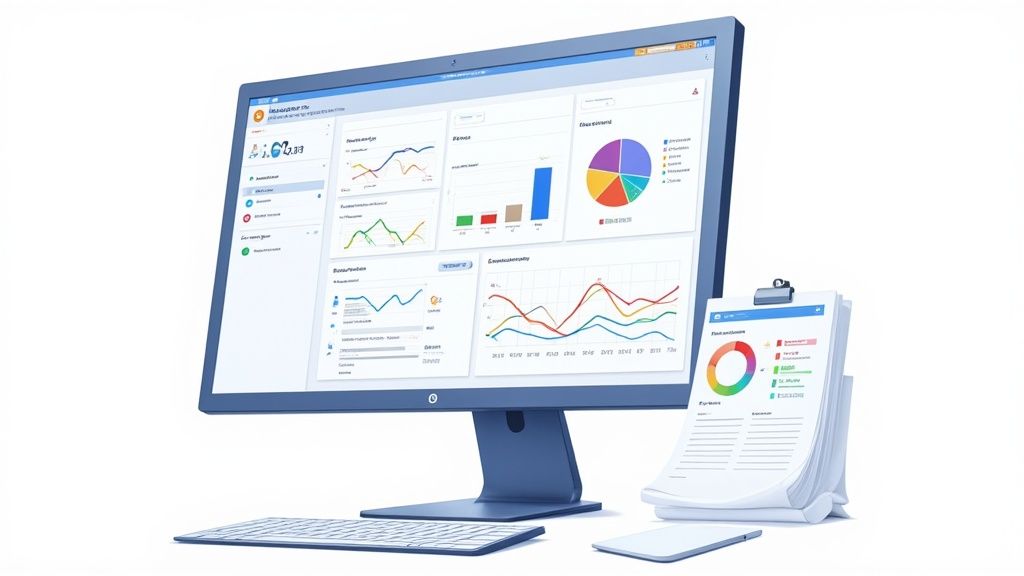
This methodology, championed by frameworks like Demo2Win and insights from platforms like Gong.io, focuses on co-creation rather than presentation. For instance, a representative for Miro might invite a prospect to add sticky notes to a collaborative board, or an Airtable specialist could have the client build a simple database using their own data during the call. This hands-on approach makes the product's benefits tangible and personal. The primary benefit is that it helps prospects internalize the value proposition and build a sense of ownership over the solution before the deal is even signed.
How to Implement This Strategy
Making a demo interactive requires planning and a willingness to cede some control to the prospect. The goal is to guide them through a discovery process within your product environment.
- Ask Questions Frequently: Pause every 3-5 minutes to ask open-ended questions like, "How do you see your team using this feature?" or "Does this align with how you handle [specific process] today?" This re-engages the audience and gathers real-time feedback.
- Use the Prospect's Data: When possible and secure, populate the demo environment with the prospect's actual data, such as their company logo, team member names, or sample project information. This creates an immediate and powerful connection.
- Encourage Hands-On Exploration: Give the prospect control of the mouse and keyboard for a specific, guided task. Ask them to create a report or configure a setting that solves one of their stated pain points. To truly make your demos interactive and engaging, explore these innovative ideas for interactive sales presentations.
Key Insight: When a prospect actively uses your product to solve a problem during the demo, they are no longer just evaluating software; they are test-driving their future success.
By fostering an interactive environment, you move beyond simply showing features and start demonstrating real-world value. This engagement deepens their understanding and builds momentum toward a close. This principle of engagement is also a core element when you use video for lead generation, as it captures attention and drives action. An interactive demo achieves the same goal, turning passive viewers into active participants and future champions of your product.
5. Handle Objections Proactively
Leaving objections to chance is one of the quickest ways to derail a promising product demo. Instead of waiting for a prospect to voice a concern and then reacting defensively, the most effective presenters anticipate and neutralize potential roadblocks proactively. This strategy involves addressing common questions, doubts, and perceived risks before they are even raised, transforming potential deal-breakers into opportunities to build trust and demonstrate expertise. A demo that tackles the tough questions head-on shows confidence and transparency, assuring the prospect that you understand their concerns.
This approach is a core tenet of modern sales methodologies like the Sandler Selling System, which emphasizes addressing potential issues early to maintain control of the conversation. For instance, a DocuSign representative might proactively discuss their multi-layered security and compliance protocols before the prospect even asks, knowing it's a critical concern for any enterprise client. Similarly, a Zendesk salesperson often brings up integration capabilities with existing tech stacks, preemptively solving a common implementation worry. This foresight proves you’ve done your homework and aren't afraid to discuss potential challenges, which significantly improves the product demo experience.
How to Implement This Strategy
Integrating proactive objection handling into your demos requires preparation and a deep understanding of your market's common sticking points. The goal is to weave these points into your narrative smoothly, not as a defensive checklist.
- Create an Objection Handling Playbook: Document the top 10-15 most common objections you hear regarding price, implementation, security, and competitors. For each, script a concise, confident, and value-driven response.
- Address the "Big Three" Early: Identify the three most frequent objections and make a point to address them within the first half of your demo. For example, you could say, "Many of our customers are initially concerned about data migration, so let me show you how we've made that process seamless."
- Use Social Proof as a Shield: Leverage customer testimonials and case studies to counter objections before they surface. You can introduce a feature by saying, "A common challenge in this industry is X, but [Client Name] used this exact feature to overcome it, increasing their efficiency by 30%."
Key Insight: Proactively handling objections shifts your position from a seller defending a product to a trusted advisor guiding a partner toward a solution. It’s a powerful move that builds credibility and keeps the momentum positive.
By anticipating and resolving concerns upfront, you control the narrative and prevent the prospect from getting stuck on a single issue. This technique is a cornerstone of improving product demos experience to close more deals because it builds a foundation of trust and demonstrates that your solution is not just powerful, but also practical and secure for their specific business needs.
6. Use Real Data and Realistic Scenarios
Generic placeholder data like "John Doe" and "Test Company" immediately breaks the immersion of a product demo. When prospects see unrealistic information, it creates a mental barrier, forcing them to translate how your solution might apply to their world. Using their actual data or highly realistic, industry-specific scenarios eliminates this friction, allowing them to instantly visualize the product’s value within their own operational context. This moves your demo from a theoretical showcase to a practical, tangible experience.
This technique is a cornerstone of modern account-based marketing and is heavily promoted by demo automation platforms like Consensus. The goal is to make the prospect feel like they are already using the product. For instance, a Tableau representative might ask for a sample spreadsheet to import during the demo, instantly creating relevant data visualizations. Similarly, a Salesforce admin can quickly set up a demo environment branded with the prospect's logo and populated with roles and workflows that mirror their current team structure. This personalization makes the solution feel less like a foreign tool and more like an integrated part of their future success.
How to Implement This Strategy
Integrating realistic data requires a bit of upfront effort, but the payoff in prospect engagement is immense. The key is to make the demo environment as familiar as possible.
- Request Sample Data: When scheduling the demo, politely ask if the prospect can provide a small, non-sensitive data sample (like an anonymized customer list or project plan). Explain that this will help you create a more relevant and valuable experience for them.
- Create Industry-Specific Templates: If real data isn't an option, build out pre-configured demo environments for your key verticals. An environment for a healthcare client should feature patient-centric terminology and HIPAA-related fields, while one for a manufacturing client should include supply chain and inventory examples.
- Incorporate Their Branding and Terminology: Use the prospect’s company name, logo, and the specific language they used during discovery calls. If they call their customers "members" or "clients," use that exact term throughout the demo to build a strong sense of familiarity.
Key Insight: When prospects see their own world reflected in your product, they stop evaluating features and start envisioning outcomes. This is a critical step in improving your product demos experience to close more deals.
By grounding your demonstration in reality, you effectively bridge the gap between your product's capabilities and their business needs. This approach is fundamental to properly educating prospects on how your solution solves their specific challenges. You can learn more about educating customers on your product to further enhance this strategy. When the demo feels like a day in their life, the decision to buy becomes a natural next step, not a leap of faith.
7. Perfect Your Demo Flow and Timing
A product demo without a clear structure is like a road trip without a map; you might eventually reach a destination, but the journey will be confusing, inefficient, and likely to lose your passengers' interest. Perfecting your demo flow and timing means orchestrating a seamless narrative that guides your audience from their initial problem to your product's ultimate solution. This involves meticulous planning of each segment, allocating appropriate time, and ensuring a logical progression that builds momentum and keeps prospects engaged from start to finish.
This disciplined approach, inspired by frameworks like the Demo2Win methodology and presentation principles from experts like Garr Reynolds, transforms your demo from a feature-dump into a compelling story. For example, Slack often structures its demos using the 'Rule of Three,' focusing on three core use cases that solve a prospect's main communication challenges. Similarly, Zoom might build a demo around the lifecycle of a meeting, from scheduling to follow-up, creating a logical and relatable flow. This careful pacing respects the audience's attention span and ensures you deliver the most impactful information without overwhelming them, a key factor in improving your product demos experience to close more deals.
How to Implement This Strategy
To master your demo's flow and timing, you need to be intentional about its structure and practice its delivery until it feels natural and effortless. This involves breaking down the presentation into manageable parts and being mindful of the clock.
- Create Modular Demo Sections: Design your demo in self-contained "modules" or "blocks" that correspond to specific pain points or use cases. This allows you to easily customize the flow for different audiences without having to reinvent the entire presentation.
- Practice with a Stopwatch: Rehearse your demo multiple times, timing each section. This helps identify areas where you might be spending too much time or rushing through critical information, allowing you to refine your pacing.
- Build in a Buffer: A common mistake is scheduling a demo that fills the entire allotted time. Always build in a 25% buffer for unexpected technical issues, deeper questions, and organic conversation. If you have a 30-minute slot, aim for a 20-22 minute core demo.
Key Insight: The goal of a well-timed demo isn't to rush through features; it's to control the narrative and create a deliberate journey that makes your solution feel like the inevitable conclusion.
By carefully choreographing your demo's flow, you demonstrate professionalism and respect for the prospect's time. This structured approach ensures clarity, maintains engagement, and leaves a lasting, positive impression. You can discover more techniques by exploring these SaaS demo best practices. When your demo feels polished and purposeful, it builds confidence in your product and your company, moving you one step closer to the sale.
8. Follow Up Strategically After the Demo
The product demo doesn't conclude when the video call ends; its impact is solidified in the follow-up. A strategic follow-up process is the bridge between a positive demo experience and a closed deal. It involves a systematic approach to post-demo communication that maintains momentum, reinforces value, and clearly guides prospects toward the next logical step. Neglecting this crucial phase allows the excitement generated during the demo to fade and opens the door for competitors to capture their attention.
This systematic engagement, popularized by sales platforms like Outreach and SalesLoft, transforms a one-time presentation into an ongoing, value-driven conversation. For instance, after a demo, a HubSpot representative might send a customized ROI report based on the prospect's data, while a Salesforce account executive provides a detailed implementation timeline and resource guides for different stakeholders. This proactive approach addresses lingering questions, equips the internal champion, and demonstrates a commitment to the prospect's success long before a contract is signed. The primary benefit is maintaining control of the sales cycle and preventing deals from stalling due to inaction or uncertainty.
How to Implement This Strategy
A swift, relevant, and well-organized follow-up can significantly improve your product demos experience to close more deals. It’s not just about sending an email; it’s about providing a resource package that makes the decision-making process easier for the entire buying committee.
- Send a Recap Within Two Hours: While the demo is still fresh in their minds, send a follow-up email. This timeliness shows you are organized, attentive, and respect their time.
- Include Key Assets and Summaries: Your email should contain a link to the demo recording, a concise summary of the key challenges discussed and how your product solves them, and any specific resources you promised (like case studies or security documentation).
- Clearly Outline Next Steps: Never leave the next action ambiguous. Propose a specific date and time for a follow-up call to discuss a trial, pricing, or an implementation plan. Ideally, you should schedule this next meeting before the prospect even leaves the current demo session.
- Equip Your Champion: Provide a one-page summary or a short video clip that your main contact can easily share with other stakeholders who were not present. This makes it simple for them to advocate on your behalf internally.
Key Insight: A strategic follow-up isn't about checking a box; it's about providing the right information to the right people at the right time to eliminate friction in their buying journey.
By implementing a structured follow-up system, you move beyond simply showing your product and begin actively managing the sales process. This final step is often the deciding factor that separates deals that close from those that go cold. When your follow-up is as professional and personalized as your demo, you build unstoppable momentum and guide your prospects confidently toward a final decision.
8 Tips for Product Demo Success Comparison
Transforming Demos into Deals: Your Path to Higher Conversions
The journey from a scheduled product demo to a closed deal is rarely a straight line. It's a carefully orchestrated experience built on empathy, strategy, and precision. We’ve explored the foundational pillars of high-conversion demonstrations, moving beyond the simple "show and tell" approach to embrace a more consultative and value-driven methodology. The eight tips for improving product demos experience to close more deals aren't just isolated tactics; they are interconnected components of a single, powerful engine designed to build trust and prove value. When you master them, you transform a potentially mundane presentation into a pivotal moment in your prospect's decision-making process.
Let's revisit the core principles that form this transformative framework. It all begins with knowing your audience on a granular level, moving from a generic pitch to a tailored conversation. This deep understanding allows you to craft a compelling demo story that positions your prospect as the hero and your product as the essential tool that enables their success. By focusing relentlessly on business outcomes over features, you align your solution directly with their strategic goals, making the value proposition tangible and undeniable.
From Passive Viewing to Active Partnership
A truly effective demo is never a monologue. The most critical shift in mindset is moving from a presenter to a facilitator. This is where interactive and engaging elements become indispensable. You invite your audience into the experience, turning them from passive observers into active participants. This hands-on approach naturally surfaces questions and concerns, which you can then handle proactively with confidence and transparency, turning potential roadblocks into opportunities to build even greater trust.
To make the theoretical feel real, you must anchor your demonstration in authenticity. Using real data and realistic scenarios allows prospects to see themselves using your product, visualizing the direct impact it will have on their daily operations and long-term objectives. This entire experience is wrapped in a meticulously planned structure, with perfected demo flow and timing that respects your audience's time while maximizing impact. Finally, the conversation doesn't end when the demo does. A strategic, value-added follow-up reinforces your message, maintains momentum, and makes the next step toward a partnership feel both logical and compelling.
The Lasting Impact of a Mastered Demo
Why is mastering these concepts so crucial? Because in a competitive market, your product demo is often the most significant opportunity you have to differentiate your solution and your company. It’s where your brand promise meets reality. A generic, feature-dump demo communicates a lack of understanding and care, while a personalized, value-driven experience signals a true partnership. By consistently applying these principles, you are not just selling software; you are building relationships and establishing yourself as a trusted advisor.
The ultimate goal is to make the value of your solution so self-evident that the decision to move forward feels like the most natural conclusion. Your demo should leave the prospect feeling understood, empowered, and confident that you hold the key to solving their most pressing challenges. This is the essence of transforming demonstrations into deals.
For organizations aiming to elevate every aspect of their sales and marketing collateral, from polished demo recordings to compelling case study videos, having a reliable creative partner is essential. An on-demand creative infrastructure can ensure that the powerful story you craft in your live demos is consistently and professionally reflected across all your customer-facing assets, creating a cohesive and persuasive brand experience that accelerates growth and drives revenue.



